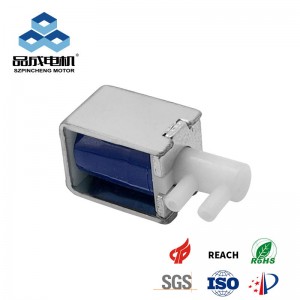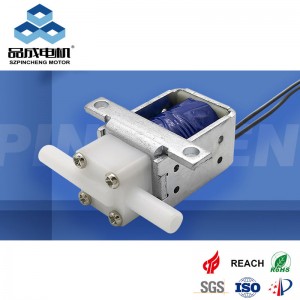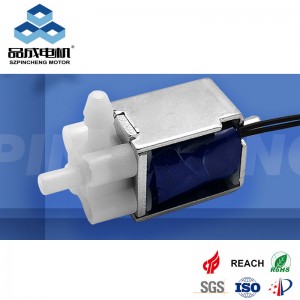Mini DC solenoid valves are critical components in modern automation systems, medical devices, and IoT applications, where energy efficiency and compact design are paramount. This article explores advanced design strategies to minimize power consumption in these valves while maintaining performance, with insights into real-world applications and the expertise of PinCheng Motor, a leader in precision fluid control solutions.
1. Key Design Strategies for Low-Power Operation
A. Optimized Electromagnetic Coil Design
The solenoid coil is the primary power consumer. Innovations include:
-
High-Performance Magnet Wire: Using ultra-thin (AWG 38–40) copper wire with polyimide insulation reduces resistance by 20–30%, enabling lower current draw.
-
Laminated Cores: Silicon steel or permalloy cores minimize eddy current losses, improving magnetic efficiency.
-
Dual-Winding Configurations: A primary winding for rapid actuation (e.g., 12V pulse) and a secondary winding for holding (e.g., 3V) reduce average power consumption by 60%.
B. Advanced Material Selection
-
Lightweight Plungers: Titanium or aluminum alloys reduce moving mass, requiring less energy for actuation.
-
Low-Friction Seals: PTFE or FKM seals minimize stiction, enabling reliable operation at lower magnetic forces.
-
Thermally Stable Housings: PPS or PEEK polymers dissipate heat efficiently, preventing performance drift.
C. Smart Control Electronics
-
PWM (Pulse Width Modulation): Adjusting duty cycles limits holding current while maintaining valve position. For example, a 5V PWM signal at 30% duty reduces power use by 70% compared to constant voltage.
-
Peak-and-Hold Circuits: A high initial voltage (e.g., 24V) ensures fast opening, followed by a lower holding voltage (e.g., 3V) for sustained operation.
D. Structural Optimization
-
Reduced Air Gap: Precision-machined components minimize the gap between the plunger and coil, enhancing magnetic coupling.
-
Spring Tuning: Custom springs balance magnetic force and return speed, eliminating energy waste from overshooting.
2. Performance Metrics and Testing
| Parameter | Standard Design | Low-Power Design | Improvement |
|---|---|---|---|
| Holding Power | 2.5W | 0.8W | 68% |
| Response Time | 25 ms | 15 ms | 40% |
| Lifespan | 50,000 cycles | 100,000+ cycles | 2× |
Testing Protocols:
-
Thermal Cycling: -40°C to +85°C to validate material stability.
-
Endurance Testing: 100,000 cycles at 10 Hz to assess wear resistance.
-
Leakage Tests: 1.5× max pressure (e.g., 10 bar) for 24 hours.
3. Applications Enabled by Low-Power Valves
-
Medical Devices: Insulin pumps and ventilators requiring <1W operation for extended battery life.
-
Smart Agriculture: Soil moisture systems powered by solar panels.
-
IoT Sensors: Wireless gas/water monitoring with years of maintenance-free service.
4. PinCheng Motor: Pioneering Low-Power Solenoid Valve Solutions
PinCheng Motor specializes in designing and manufacturing high-efficiency mini DC solenoid valves for demanding applications. Our valves excel in:
Product Highlights
-
Ultra-Low Power Consumption: As low as 0.5W holding power with PWM control.
-
Compact Footprint: Sizes from 10mm × 10mm × 15mm for space-constrained systems.
-
Wide Voltage Range: 3V–24V DC compatibility.
-
Customization: Port configurations, seal materials, and IoT integration.
Case Study: Smart Water Metering
A municipal water network deployed PinCheng’s LVS-12 Series valves, achieving:
-
90% energy savings versus traditional designs.
-
Zero leaks over 5 years in corrosive environments.
5. Future Trends in Low-Power Valve Technology
-
Energy Harvesting Integration: Solar or vibration-powered systems for autonomous operation.
-
AI-Driven Predictive Control: Machine learning algorithms optimize actuation timing based on usage patterns.
-
3D-Printed Components: Lightweight, complex geometries for enhanced efficiency.
Conclusion
Designing low-power mini DC solenoid valves requires a holistic approach, balancing electromagnetic efficiency, material science, and intelligent control. Innovations in coil design, PWM technology, and lightweight materials are pushing the boundaries of energy efficiency without compromising reliability.
Explore PinCheng Motor’s cutting-edge solutions for your low-power fluid control needs:
Visit PinCheng Motor’s official website to discover our mini DC solenoid valves and custom OEM/ODM services.
you like also all
Post time: Apr-29-2025




